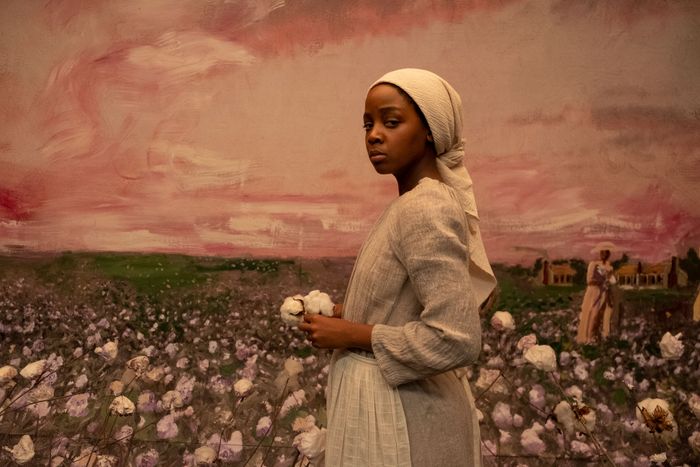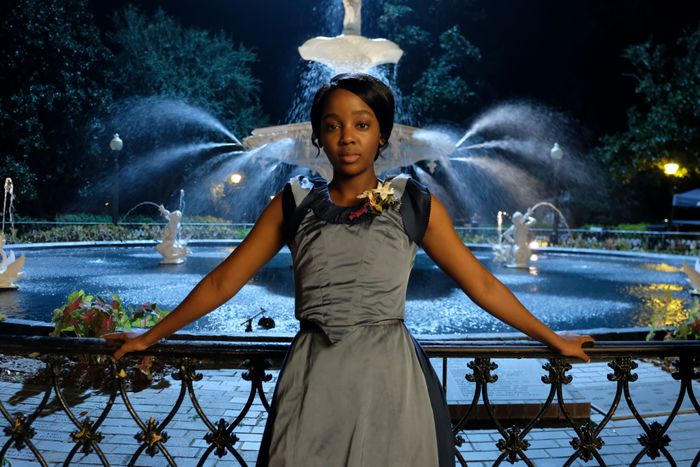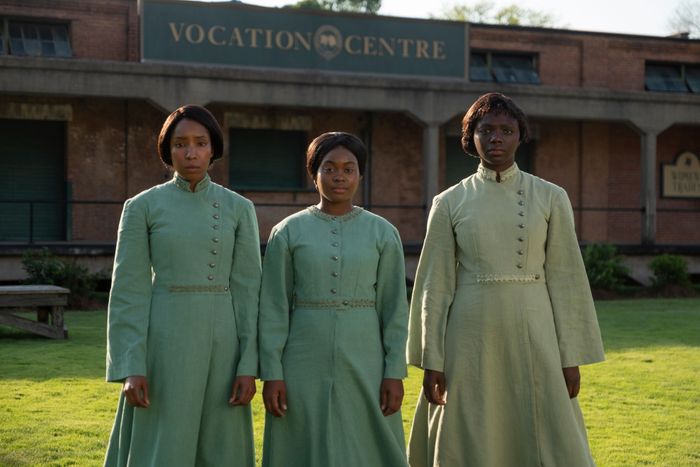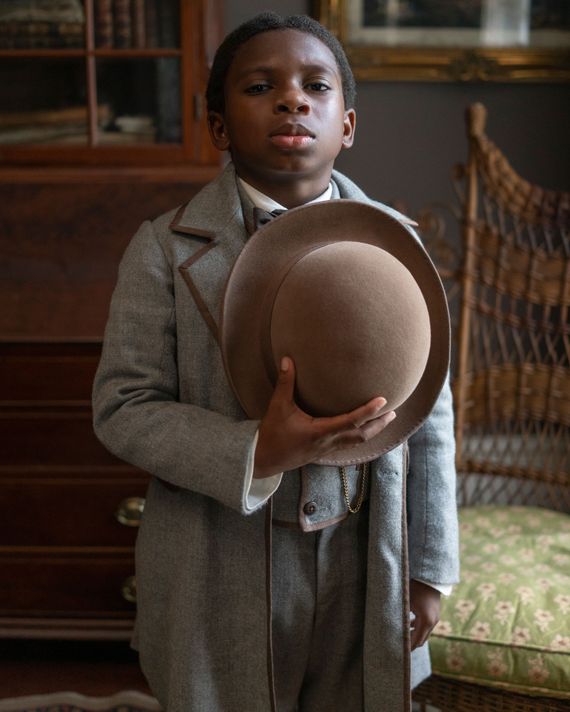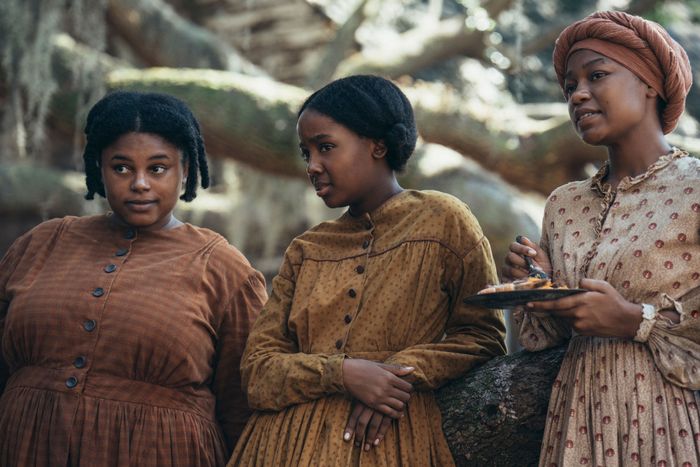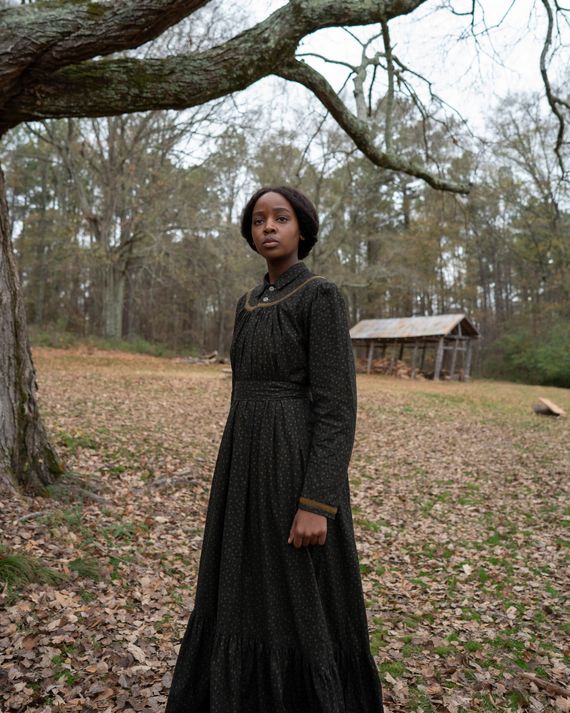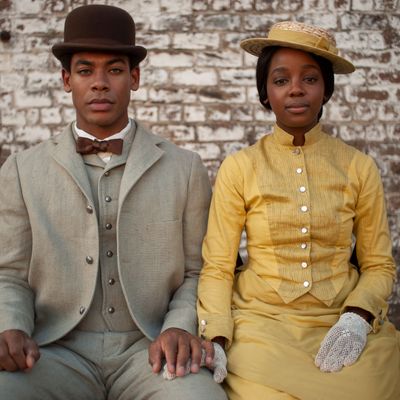
No fewer than three times during our conversation, costume designer Caroline Eselin struggles to choose the right words to describe her experience of working on The Underground Railroad, Oscar-winning writer-director Barry Jenkins’s stunning ten-part series that poetically blends history with fiction and magical realism. Adapted from Colson Whitehead’s Pulitzer-winning 2016 novel, the story charts the arduous, perilous, and harrowing journey of Cora (Thuso Mbedu), a slave who escapes her plantation in antebellum-era Georgia and gets ceaselessly chased by the ruthless bounty hunter Ridgeway (Joel Edgerton). So words with positive connotations, like “thrilling” or “a dream,” feel inappropriate to Eselin, even though her third collaboration with Jenkins after Moonlight and If Beale Street Could Talk couldn’t have yielded a more rewarding process for the artisan.
“Without a doubt, it’s the biggest, the most challenging, educational, and valuable thing I’ve ever done,” she tells me over Zoom, only a day after Jenkins dropped The Gaze, an evocative and magnetic nonfiction companion piece to The Underground Railroad, in which the filmmaker honors the Black Gaze through a 52-minute series of portraits of mostly background actors. “I wrote to Barry yesterday [after] he released that reel. He’d shot all these portraits during the show. I didn’t realize that he had gotten so many. It was amazing to see my department’s work [displayed] in these full-frame lengths: beautiful, haunting, gorgeous portraits. And with those portraits, you see the truth.”
Seizing and transmitting that truth as Cora treks from Georgia to South Carolina, North Carolina, Tennessee, and Indiana — both above the ground and surreally through a network of a literal, below-the-ground rail system — was Eselin’s guiding principle in designing the show’s costumes, a massive undertaking with about 110 principals, 90 or so stunt performers, and nearly 3,000 background actors. “We built, we built, we built,” she adds. “We had some incredible tailors on the show; an incredible cutter-fitter and milliner. It’s hundreds or thousands of garments that we made.”
Here’s how Eselin pulled off the monumental amount of work in support of Jenkins’s artistic vision for the series.
The costumes had to be subtle, sometimes even invisible.
“The whole piece is a costume piece. But I hoped that [the clothes] were quiet and helped serve the story in the most natural way,” indicates Eselin. The artisan went to great lengths to walk a fine line between the story’s historical enormity and the design subtlety that kind of substance demanded. She purposely stayed away from sheen and shiny fabrics. “I wanted to make sure that we never stole the limelight. If the costumes are invisible sometimes, [then that’s] good, we’ve done our job.”
Not competing with the faces, and the dignified way in which Jenkins filmed them, was especially imperative for her. “Thuso’s face alone,” she gushes. “She’s a chameleon. She goes from looking like a teenager [one moment] to an older woman [the next]. I didn’t want your eye to go anywhere else.”
Restraint also meant cutting back on the individual outfits of the main cast, especially Cora, to properly represent the constraints of the era. “With Barry, less is more. In the beginning, for Georgia, we had four dresses for Cora, but Barry said, ‘Too many, too many!’ That happened throughout the show. Cora has two dresses in North Carolina, and maybe four in Indiana. There [were] moments [like in South Carolina] where we needed to be bigger, but I still hope those bigger moments didn’t take away from the story.”
Every state features a distinct, purposeful color palette.
To Eselin, each chapter required its own deliberate world-building. Color was a key component of how she approached the series’s progression from state to state, with an evolving palette that was never loud. “Georgia was muted and drab,” she says about the segment set in and around the Randall plantation, from which Cora escapes. But then Griffin, South Carolina, a place that looks like a paradise of progressive values but in fact is home to a secret practice of racial eugenics, had to be an explosion of Technicolor, conveying the artificial optimism in the air. “You know, yellows, greens, blues, and real true colors that you don’t get in Georgia.”
She continues, “North Carolina is such a horrific place. Every place is, but what happens to Black people when they get caught in North Carolina is absolutely terrible. We kept the palette very dark for that wicked world.” The garments in Tennessee, where yellow fever and fires were rampant, were also conceived with suitably gloomy shades, whereas the looks in Indiana, where Cora joins a prosperous Black community at a farm, were caressed with an effortless, hopeful, natural wash. In that regard, Cora’s green dress, a staple for the Indiana episodes, was an instinctive choice to complement the pastoral place that she was in. “[Green meant] new life and growth.”
At times, color was also a way for Eselin to gently mislead the audience for narrative purposes. “In [Georgia], we meet Cora in a yellow-orange dress, at the time of a birthday party. You don’t know what a horrific place she’s in. So we wanted to have a moment of like, ‘Oh, maybe this isn’t so bad.’ And then it turns terrible. Cora [being] in her best dress [throws you off]. Again, in South Carolina, her yellow dress is about optimism. And the blues that she wears there are straight from the book. James Baldwin wrote a lot of green for Beale Street. Colson Whitehead wrote a lot of blue.”
Time periods were bent and merged to amplify the themes and intentions of the series.
True to Whitehead’s novel, the series is set around the mid-1800s before the Civil War, though it also integrates certain aspects of the future into its narrative. This mind-bending blend of historical time frames within a sometimes fantastical framework presented Eselin her biggest challenge. “That [fluid sense of time] was [the source of] most nights of insomnia,” she remembers. The team knew early on that they wanted to be in the year 1850 and start things out straightforwardly in Georgia, aiming to invite everyone in on the journey, not only those who read Whitehead’s novel and were therefore familiar with his play on timelines.
It is when Cora gets to Griffin, South Carolina, which features an array of complex costumes that Eselin is most proud of, that they start manipulating time periods. “At one point, we talked about even jumping into the 1950s, like the Jim Crow South, and discussed putting ’50s men’s fedoras and dress shirts with 1880 suits. [But] what we [landed] on is the 1880s, because of the ‘elevators and skyscrapers’ that are mentioned in the source. Eugenics, elevators, and skyscrapers all started in the 1880s,” she explains. Consequently, Miss Lucy (Megan Boone) and others ushering the program of Negro progress but carrying out a perverted mission were dressed in 1880s looks in order to establish them as the leaders of Griffin. But the doctors were put in 1850s garments. (“Doctors were trying to control things by keeping them in the past.”)
Cora’s day and evening dresses were also born out of a hybrid of chronologies and ideas. “Barry and I treated South Carolina almost like a prison. When enslaved people are bought from plantations, the men are issued a suit and workwear if they work at the quarry like Caesar (Aaron Pierre) does. The women are issued an institutional dress, a day dress, and, if they work in the museum like Cora, their museum costumes.” The whole bodice of Cora’s everyday dress, a formfitting, double-breasted, uniformlike garment with clean lines and side buttons, was in the 1880s, whereas its bell sleeves resembled the 1850s. “We didn’t put a bustle in the back of that skirt. We really wanted it to be more like an institutional work dress, but it’s edging towards the turn of the century.”
For North Carolina, where Cora hides in the attic of a white couple (Damon Herriman and Lily Rabe), Eselin turned to the autobiography of Harriet Jacobs, Incidents in the Life of a Slave Girl, also mentioned in Whitehead’s book. Jacobs lived in an attic for seven years, hiding from her captors sometime in the 1830s. And while the series is almost a year into the 1850s by the time Cora arrives in North Carolina, Eselin says the clothes signify a step back in time, a regression from South Carolina as seen through Cora’s consciousness. Hence, the North Carolina dresses boast dramatic, 1830s bulbous sleeves, immense volumes, and petticoats of the past.
While Tennessee, another dark chapter, was kept within the straightforward 1850s reality, Indiana, a prosperous place of hope for Black people, was where the designer merged time periods once again. “In Indiana, Cora is in a progressive community, a utopian [society]. So we had our white population dress in the 1850s to keep them in the past. And then we put our Black population in the 1880s, up until about the turn of the century, to place them more in the future.”
The passage of time also threw some unexpected, real-world setbacks Eselin’s way. Before resuming last summer, the production shut down back in March 2020 due to the pandemic, with only three days left of shooting. So that meant tweaking the costumes of the young performers, particularly of Homer (Chase Dillon), who accompanies Ridgeway throughout his pursuit of Cora in a grown-up three-piece suit of gray tones. “Chase grew during production, and about [an additional] two inches in lockdown. So there was always a bit of refit to make sure that everything was still okay.”
The authenticity of fabrics and silhouettes, as well as believable wear and tear, was crucial.
“We had an incredible aging-dying department,” says Eselin gratefully, as it was vital for her to make sure that the pieces Cora wore properly reflected her physical and emotional journey. “When Caesar and Cora escape the plantation, when they go through the swamp, we needed to make sure that those clothes had been through that journey.”
Sometimes, plausible wear and tear meant building the same dress many times over, like they did for Cora’s dress of brown tones in “Chapter 5: Tennessee — Exodus.” “She tries to die in a pond and we got ten versions of her dress ready in different stages of water levels.” Similarly, her escape dress in the beginning had water levels on it from the swamp she walks through. “We had dirt samples from every location and we used them [for guidance].”
As for fabrics, Eselin stuck with whatever felt the most natural — a lot of cottons, wool, and some silk. For Georgia, it was mostly cottons: washed, rewashed, sun-bleached. In North Carolina, she used fabrics that were on the rougher side: burlaps, roughened wools, and linens. Cora’s dress in which she walks out of the North Carolina house is meant to be the daughter’s dress they find in the attic. “That’s why it is short and ragdoll-like. That dress [that she gets dragged in through Tennessee like a child] is from the 1810s, like a teenager’s dress.”
She continues, “Barry wanted [Indiana] to be impossibly beautiful. [So] we opened it up to more jewel tones, just beautiful fabrics and [a lot more] prints. Doris Raymond at The Way We Wore here in Los Angeles gave me some things she had at her warehouse that were incredible. I got about a dozen 19th-century original men’s work shirts. She also gave me this chore dress (or wrappers, they’re called) that unlocked the whole idea for Indiana [and] became sort of what the women would wear in the vineyard and on the farm; all the little ditzy, beautiful prints [we see on everyone].”
Eselin loves all those exquisite prints so much that she effusively wishes to reproduce a thousand of them someday. Considering the refinement with which she pulled off The Underground Railroad’s absolutely gigantic scope, she probably could.


